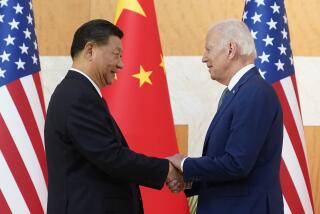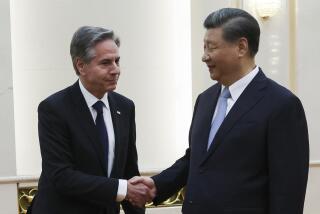Nepal caught between China and India
- Share via
Reporting from Katmandu, Nepal — A recent recording making the rounds in Nepal featured a Maoist party leader speaking to a man with a Chinese accent. During the 12-minute tape, the Chinese voice offers $6.9 million to bribe 50 Nepali legislators for help in forming a Maoist-led government that would favor China over India.
Whether the tape is genuine, whether the voice is really that of a Chinese official and whether India’s intelligence wing released it as part of a propaganda exercise haven’t been established.
But the tape reinforced a long-standing view in Nepal: The strategically located, landlocked nation of 30 million people is a playground for its two giant neighbors. A “delicate yam between two boulders” is the way King Prithvi Narayan Shah summed it up as far back as the 18th century.
Early this month, after 17 attempts to name a prime minister, reflecting Nepal’s political paralysis, Jhalnath Khanal was picked for the post. Among the many challenges facing the new leader is balancing relations with the two neighbors.
“My government will deepen and strengthen the relationship with both” India and China, Khanal said shortly after his election. . “I haven’t decided yet” which country to visit first.
For much of its history, Nepal has been heavily influenced by India. Four million Nepalese work in India. And a long, porous border, shared religious traditions and a common history under the British Empire have bound the two.
Contact with China was long impeded by the 30,000-foot Himalayan peaks to the north.
But an ascending Middle Kingdom is changing the equation, making India anxious.
“I see Delhi as both confused and nervous,” said Bhekh B. Thapa, Nepal’s former foreign minister.
China’s footprints are widely evident.
Beijing is building a $1.9-billion railroad from the city of Lhasa to the Tibet-Nepal border that may eventually reach Katmandu. Chinese trade, aid and infrastructure projects are pouring in.
“Now China is the goose with the golden eggs,” said Kesang Tseten, a Katmandu-based documentary filmmaker.
Nepali politicians traveling to Beijing are tripping over one another as China funds Nepali police training, border control, roads, even garbage trucks.
“The new China is flexing its muscles in line with its economic might,” said Kanak Mani Dixit, Katmandu-based editor of Himal Southasian magazine. “It’s also trying to rattle India.”
India has traditionally viewed Nepal as a buffer against China, with which it lost a war in 1962. Last month, India arrested three Chinese for allegedly sneaking into India and taking pictures of strategic installations. Beijing denies that they are spies.
One key barometer of China’s growing clout here is Katmandu’s treatment of exile Tibetans, who number about 20,000 in Nepal. After unrest spread across the Tibetan plateau in March 2008, Beijing leaned heavily on Nepal’s Tibet policy.
The number of Tibetan refugees crossing into Nepal from China after 2008 fell to about 500 annually from 3,000 a year, as China provided money, equipment and training to Nepal to tighten the border, analysts said. In a leaked U.S. cable released by WikiLeaks in December, an unnamed source said China paid bounties to Nepali border guards who handed Tibetans over to China.
“The pressure has become very hard on the Nepal government,” said Trinlay Gyatso, the Dalai Lama’s de facto representative in Nepal. “There’s no reason Nepal should be a puppet. It’s a sovereign nation.”
In February, three ballot boxes used for Tibetan community elections were seized by police in riot gear, the International Campaign for Tibet reported. This followed a similar confiscation in October as Tibetan exiles here were voting for the self-proclaimed Tibetan government-in-exile based in Dharamsala, India, an exercise exiles said had taken place here 14 times since 1960 without incident.
In June, three Tibetans were arrested, transported by helicopter to the Chinese frontier and handed over to Chinese border officials, the same activist group reported. Two landed in Chinese jails.
The fate of seven other refugees arrested by Nepal authorities in October and nine detained last month isn’t known.
Last week U.S. Undersecretary of State Maria Otero expressed concern to Khanal over the problems faced by Tibetan refugees in Nepal. The prime minister reportedly responded that Nepal would deal with the issue in line with the views of its immediate neighbors, China and India.
India has long enjoyed a significant voice in Nepal’s politics. New Delhi was instrumental in brokering a 12-point agreement in 2005 under which the Maoists eventually put down their guns, ending a 10-year civil war.
But some say India’s voice has become more strident and highhanded of late, perhaps in reaction to China’s growing influence.
Late last year, stones and shoes were thrown at the motorcade of India’s controversial envoy to Nepal, Rakesh Sood, during a charity event in northern Nepal. India demanded an apology, calling the incident a “gross violation of diplomatic norms.”
Even as China and India jockey, however, both giants share interest in stability, albeit for different reasons, some analysts said.
India is concerned that its Maoist insurgency, known as the Naxalites, could link up with its Nepali cousins or use Nepal as a base, said Binod Bhattarai, an analyst and columnist at large. And China wants to put a lid on any free-Tibet activism in Nepal.
Nepalese say some foreign meddling is inevitable with such huge neighbors. When caretaker Prime Minister Madhav Kumar Nepal said in October that he wouldn’t let foreign powers interfere in internal matters, Nepal’s Telegraph newspaper called it the “best joke of the month.”
All the while, Chinese money continues to pour into Nepal, accompanied by Chinese influence and pressure.
“The trouble is, we’re right next door to the dragon,” said Kunda Dixit, publisher of the Nepali Times. “We feel the dragon’s fire on our backside.
“China’s clout is so big. No Western countries are really standing up to them; how do you expect tiny Nepal to do it?”
Special correspondent Rajneesh Bhandari contributed to this report.
More to Read
Sign up for Essential California
The most important California stories and recommendations in your inbox every morning.
You may occasionally receive promotional content from the Los Angeles Times.










